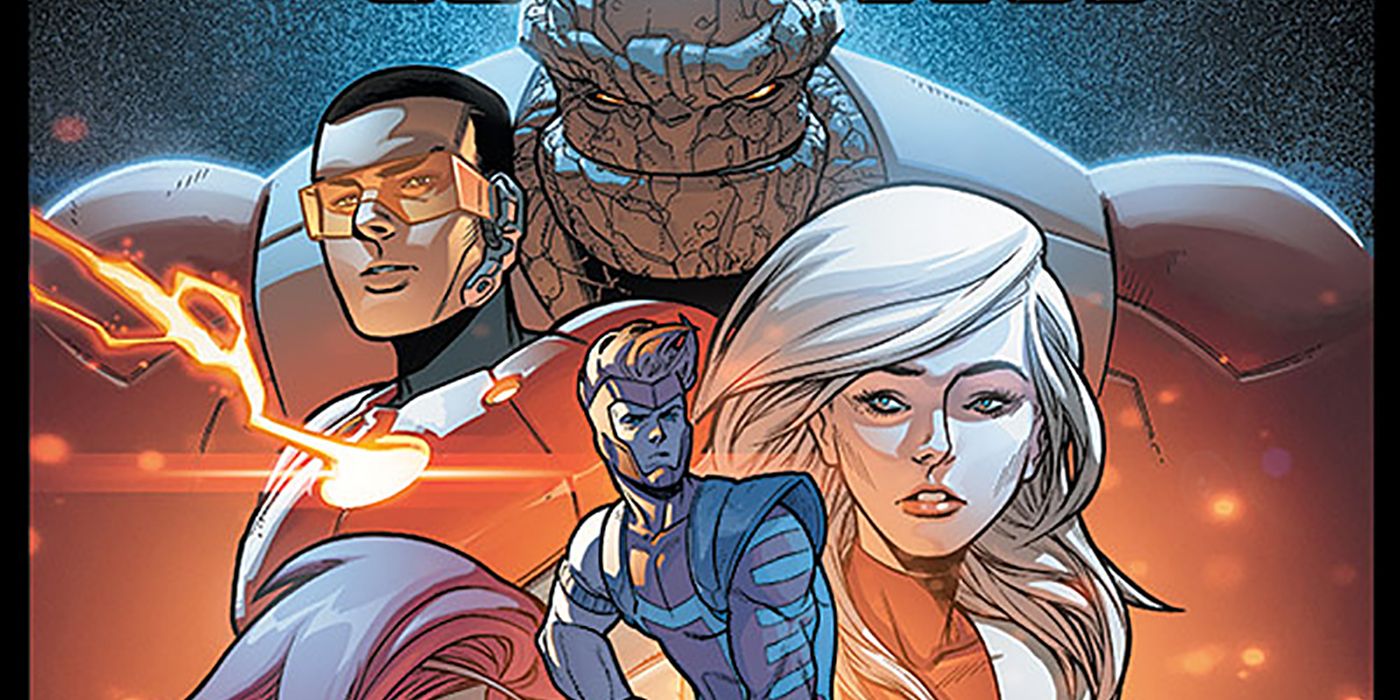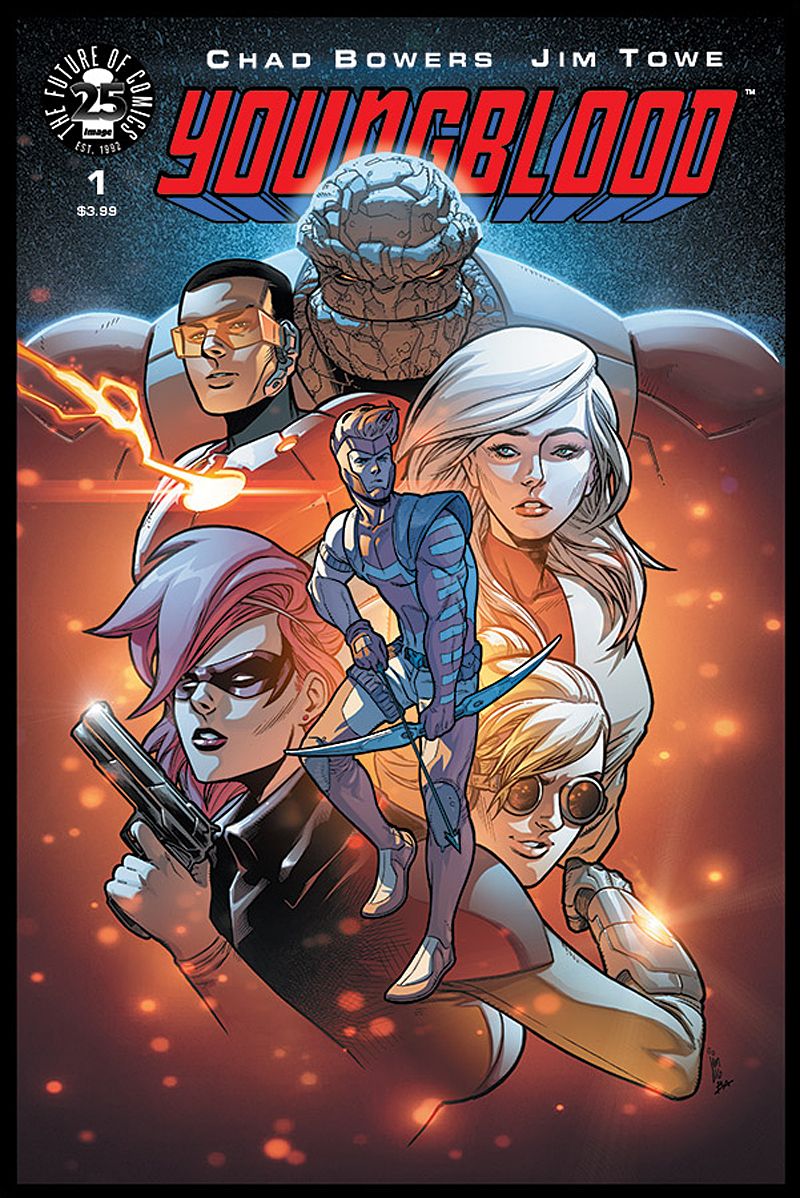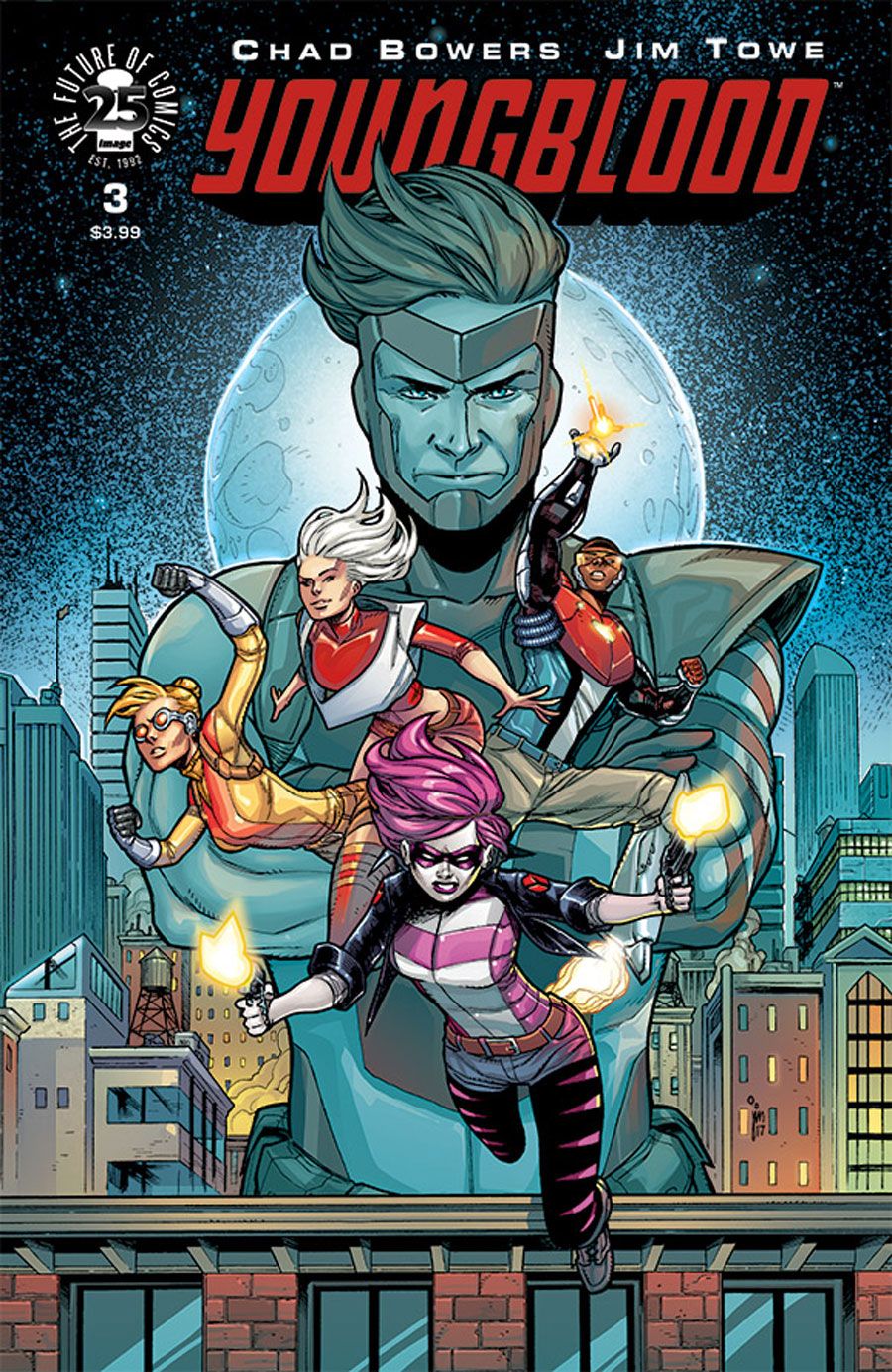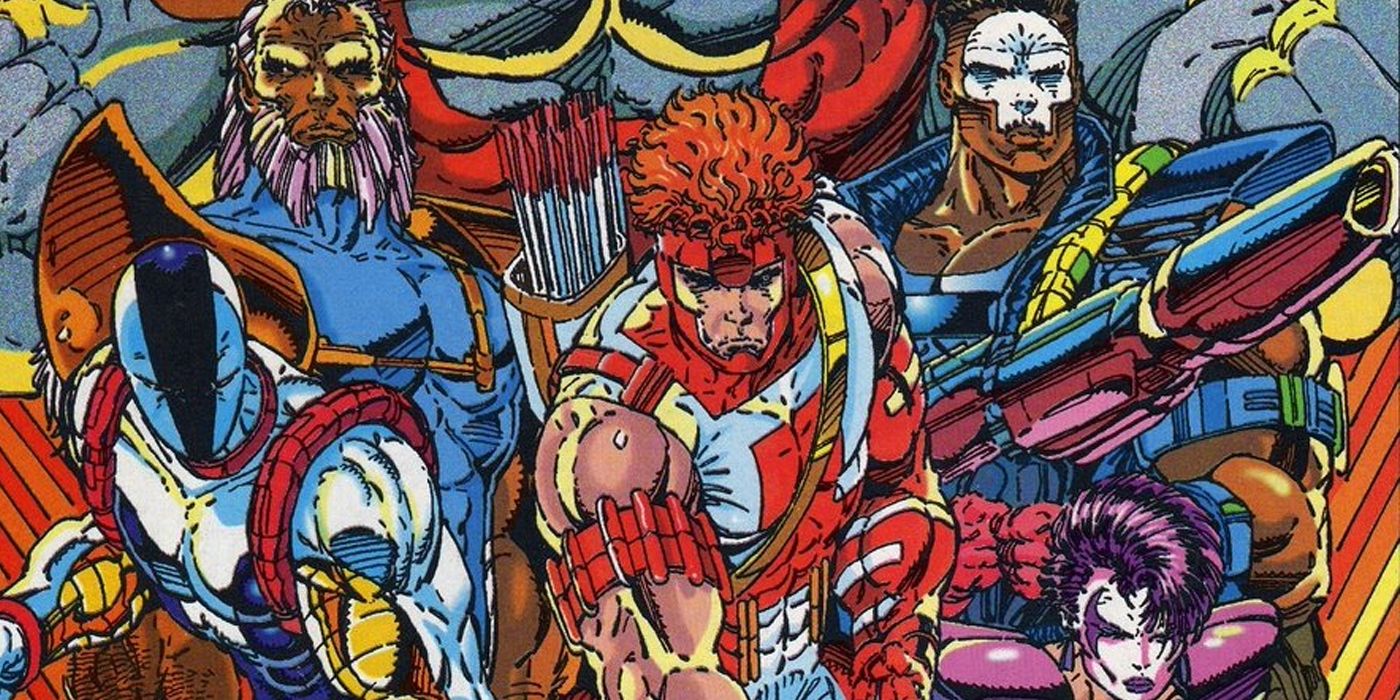Get ready to re-meet Youngblood, “the world’s most infamous super-team.” This week, the Rob Liefeld-created celebrity heroes return to Image Comics, courtesy of writer Chad Bowers ("X-Men ’92," "Deadpool: Bad Blood") and artist Jim Towe, a comics newcomer.
When Liefeld first launched "Youngblood" in 1992 -- among the first wave of creator-owned Image Comics properties along with "WildC.A.T.S." and "Spawn" -- he asked how superheroes might interact in the media-obsessed landscape of the early 1990s. With their new series, Bowers and Towe have thoughtfully updated his vision for the Internet age, replete with viral videos and Help! a sort of Uber app for superheroes. Featuring new heroes alongside classic characters like Shaft, Badrock, Diehard and Vogue, the new book pulses with a vibrant energy that feels distinct from the grim tone originally associated with the characters.
RELATED: David Finch’s Youngblood Variant Recalls Series’ 1992 Debut
Much like savvy reflection on the real life pop culture landscape, reinvention seems hardwired into the fabric of Liefeld’s characters. In the late ‘90s, Alan Moore used Liefeld’s Superman stand-in "Supreme" to tell loving, idiosyncratic Silver Age-style stories. In 2012, Brandon Graham morphed the gritty "Prophet" into a mind-bending science fiction/fantasy epic set 10,000 years in the future. That same year, writer Tim Seeley and artist Francesco Gaston offered up gonzo exuberance with their take on Liefeld’s "Bloodstrike," and Joe Keatinge and Sophie Campbell launched a surreal version of the Wonder Woman-inspired "Glory." In 2015, Warren Ellis and Tula Lotay took the Supreme mythos in a psychedelic direction with "Supreme: Blue Rose."
But few of Liefeld’s creations have been remolded as often as Youngblood. Over the years, writers like Robert Kirkman, Joe Casey and Mark Millar have each penned distinct takes on the team. Though runs have often been short -- as short as one issue -- something keeps bringing creators back to the ideas of Youngblood. Bowers and Towe seem particularly suited to the adapt Shaft and company for the digital age. Bowers’ work on "X-Men ’92" showcased his ability to tell resonant stories while playing with nostalgic themes, and the previously-unpublished Towe’s gig on "Youngblood" was literally the result of social media: Liefeld found his updated character sketches on Twitter and promptly offered him a job.
CBR spoke with Bowers and Towe to discuss Youngblood’s pop culture relevance, updating the Extreme Universe for 2017, and why their version of “The ‘Blood” has more in common with "Jurassic World" and the 2009 "Star Trek" than full-scale reboots like Warren Ellis and Jon Davis-Hunt's "The Wild Storm."
CBR: Are you approaching Youngblood as a reboot or a continuation? Do readers need to know anything about the Extreme universe to get on board?
Chad Bowers: It's a little bit of both, really. Just about everything we have planned for the first year revolves around a couple of new characters, two young heroes who find themselves involved in a mystery that takes them from one end of the Extreme Universe to the other. As we go, you'll start to see some deeper connections to the classic Youngblood team, but for the moment, at least with these first 12 issues, we're covering a lot of new territory.
Jim Towe: A main focus of ours has been to redevelop these characters from the ground up, so that we could bring a fresh, new chapter to returning fans, while also presenting an awesome introduction to first-timers.
Bowers: It’s funny, that’s probably the question we get asked the most. “Reboot or continuation?” And I always end up comparing it to something like "Jurassic World" or the J.J. Abrams' [version of] "Star Trek." Not tonally, of course -- although we might have some dinosaurs and spaceships show up -- but in the same way those franchises found a way to rebrand without getting rid of anything that made them fundamentally what they were to begin with. We’re doing that same thing.
Reinvention over reboot -- that was my preference. There's so much good stuff in Youngblood's publication history, I'd be absolutely nuts to jettison it all. But keeping things fresh and accessible to new readers is a huge priority for us, too. We're passionate about telling new stories, not just doing the greatest hits.
Help! is essentially Uber for superheroes, which feels like an extension of Rob’s original idea for the team. What is it about Youngblood that provides such an adaptable vehicle for exploring pop culture like this?
Bowers: Youngblood’s DNA is laced with pop culture influences. In the same way Kirby was predicting the Internet, virtual reality and cell phones in the ‘60s, Rob was doing the same thing with an eye toward pop culture throughout the ‘90s. He was more in touch with “cool” than anybody else, and so far ahead of the curve on the next two decades, it’s really kind of remarkable.
You can draw a straight line from the ’92 NBA Dream Team, celebrity endorsements, MTV and 24-hour news channels to those first issues of "Youngblood." Rob took pieces from each of those, and made a comic that tapped into the zeitgeist like nothing else at the time. "Youngblood" was the Avengers and the JLA but with none of the fat. They were the best of the best, wearing the coolest costumes, and they were superheroes 24 hours a day. Seven or eight years after "Watchmen" and "Dark Knight Returns," "Youngblood" went out of its way to make it cool to be a superhero again, and 13-year old Chad Bowers was way into that.
Celebrity culture is incredibly different in 2017 than it was in 1992; we know almost everything about our celebrities now. Did you guys want to reflect on this in the new series?
Towe: Absolutely, and we really wanted to jump into exploring that right out of the gate. One of the biggest differences between 1992 and 2017 is the viral nature of our media. Everything's closer than before, but simultaneously harder to find. 1992 had basketball superstars and action movie heroes, whereas 2017 is littered with gigantic viral hits that are gone in a flash. And I think our series feels closer to being a thriller than an all-out action romp as a result of the modern cultural landscape.
Jim – you got involved in this book in a really unorthodox way: you essentially pitched redesigns of the characters as an artistic exercise on Twitter and Rob saw them. What was it like to get a response from him?
Towe: Totally unbelievable. I actually took a screenshot of his reply with plans to frame and hang it above my desk or something. But honestly, those doodles were simply done as an exercise in character design. The hope was that Rob might retweet them and get me a few more followers -- the fantasy was that he'd offer me a job. It's the best tweet I have and will ever send!
There’s been no shortage of high profile creators to work on Youngblood over the years – from Alan Moore to Kurt Busiek, Robert Kirkman, Mark Millar, Keith Giffen, and Joe Casey. How did those runs influence you?
Bowers: I love that they all saw value in Youngblood and used their time on the book to do something unique, and not repeat Rob and Eric Stephenson’s formula from the ‘90s. Moore’s ingenuity is a huge motivation. I’m astounded by how much he managed to move the characters and concepts forward every time he interacted with the Extreme Universe. Who knew Alan Moore was so good at comics? I think Joe Casey's run is a spectacular examination of the reality TV craze. If it turns out you like what Jim and I do with the ‘Blood, I would suggest picking up those issues, and Casey’s rework of the original miniseries with Rob. That thing’s basically the King James Version of the Youngblood bible.
Alan Moore’s take on Youngblood referenced the original "Teen Titans" run. Is your vision more informed by the books you grew up with, like "New Mutants," "X-Men," "X-Force" and the original Image books -- "Youngblood," "WildC.A.T.S.," etc?
Bowers: I’m certainly a fan of those comics but if we’re talking about what’s influencing us most, I’d say our take on "Youngblood" is shaped by more recent stuff like "Saga," "Copra" and "The Vision." The classics, especially "X-Force" and the later-era "New Mutants," had a huge impact on me as a reader, but I’m picking up so many incredible comics off the stands now, and they all motivate me to stretch myself as a creator.
Towe: For me, the most informative work is what's come before our run on "Youngblood." Each creative team on the title since 1992 has taken it in really different directions, creating a great variety of takes on the characters. Chad and I really wanted to blend all of the various takes on "Youngblood" into one singular idea, and then take that to the modern day.
In this series, Youngblood’s history isn’t viewed particularly favorably. Chad, as an author does that provide you with the opportunity to play meta-critic to some extent, to explore the criticisms some readers or critics have had regarding Youngblood as a property?
Bowers: Reading through the first issue again, I can see why you might ask that question. Without giving too much away, our branding Youngblood as “the world’s most infamous super-team” has nothing to do with some peoples' opinions of the property, and is more about establishing the tone than anything else. The truth is, I tend to disagree with just about every negative thing critics have said about "Youngblood" over the years, and there's probably more of a temptation to defend it against the naysayers than to comment on any shortcomings. I don’t see much benefit or the need to explore decades-old commentary and criticism, not when Jim and I can focus our efforts on making people love Youngblood today!
Nostalgia is a tricky thing to play with. Obviously there’s an element of it at play in reviving a property so associated with the ‘90s as "Youngblood," but the story is rooted very much in the present. Were you consciously thinking about what relationship you wanted the series to have with nostalgia?
Bowers: With a comic like "Youngblood," nostalgia's part of the deal. You can’t outrun it, and you probably shouldn't ignore it either, because it’s a powerful and emotional motivator, and worth tapping into when it serves the story. But I genuinely believe much of what made Youngblood engaging in the first place was how it energized the superhero team model by pulling from the real world. I want what we do on the book to be a natural evolution of that characteristic more than its ‘90s roots.
Towe: Making Youngblood modern is definitely one of my main goals. I like to thinks it's that approach I took in the initial character designs that sold Rob on me, and he's been incredibly supportive of the modern flare I've brought to the book. I'm also constantly going back and looking at the early runs to find design elements to update. It's one of the funnest parts of the job.
"Youngblood" #1 is scheduled for release this Wednesday, May 3, from Image Comics.




